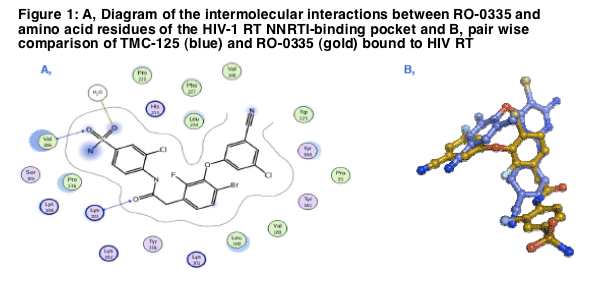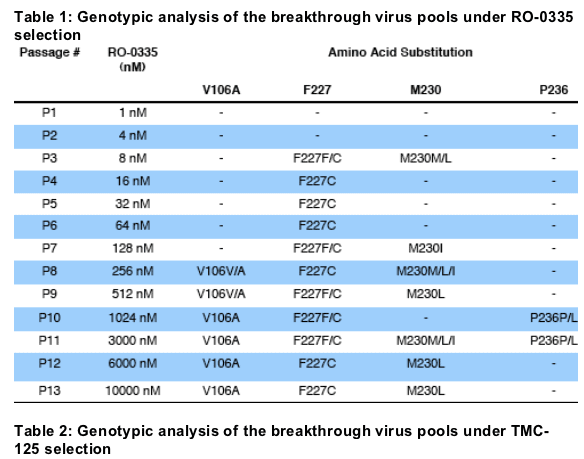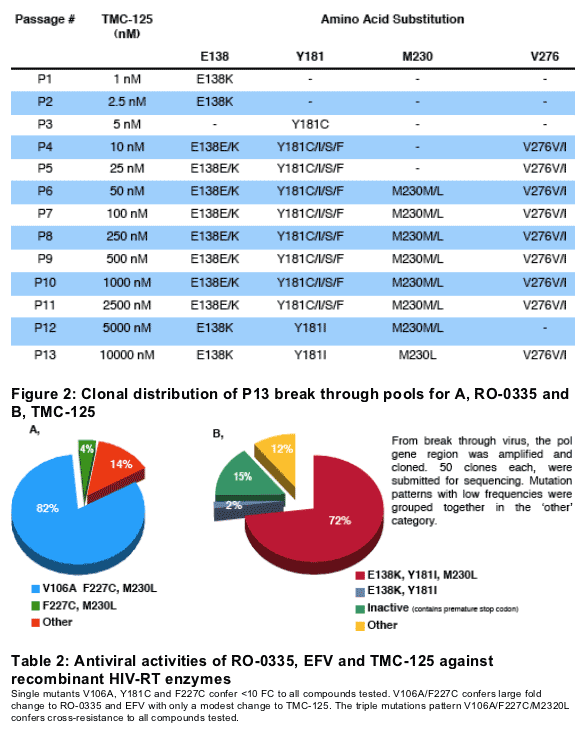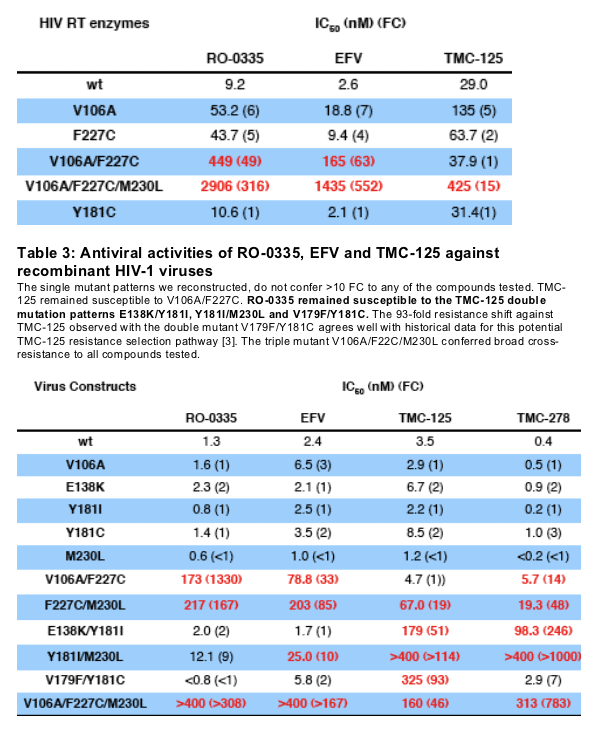 |
 |
 |
| |
Roche NNRTI Potent Against TMC125 & TMC278 Resistance In Vitro
|
| |
| |
Reported by Jules Levin
"In Vitro Selection and Characterization of Viruses Resistant to R1206, a Novel Nonnucleoside Reverse Transcriptase Inhibitor"
XVI International HIV Drug Resistance Workshop
Bridgetown, Barbados
June 12-16, 2007
Guoping Su, Yu Li, Amber Paul, Julie Hang, Seth Harris, Heather Hogg, James Dunn, JunMei Yan, Eugene Chow, Nick Cammack, Klaus Klumpp, Gabrielle
Heilek
Roche Palo Alto LLC, 3431 Hillview Avenue, Palo Alto, CA 94304, USA
AUTHOR CONCLUSIONS
Passaging of wildtype HIV-1 HXB2 virus in MT-4 cells under increasing drug pressure of RO-0335 selected for a resistant virus with the triple mutation V106A/F227C/M230L.
TMC-125 selected resistant virus under similar conditions with multiple mutations at positions E138K, V179F, Y181I/C, and M230L, as previously described.
Double mutations V179F/Y181C, Y181I/M230L and E138K/Y181I conferred resistance to inhibition by TMC-125 (FC 50-fold to > 100-fold) and TMC-278 (FC 7-fold to > 1000-fold), but were sensitive to inhibition by RO-0335 (FC <0.6 fold to 9-fold).
Recombinant HIV-1 HXB2 with V106A/F227/M230L triple mutation was resistant to inhibition by RO-0335, EFV, TMC-278 and TMC-125.
RO-0335 is a representative of a series of novel NNRTIs with high antiviral potency against wild-type and a unique resistance profile.
Introduction
Non-nucleoside reverse transcriptase inhibitors (NNRTIs) are important components of highly active antiretroviral therapy combination regiments (HAART) for the treatment of HIV-1-infected patients. Representatives of the 1st generation of the NNRTI class generally showed low genetic barrier to resistance, manifesting as relative rapid selection of resistance mutations and extensive cross-resistance exists within the class. R1206 is a prodrug of RO-0335 and represents a new class of potent diphenylether non-nucleoside reverse
transcriptase inhibitors. Here we describe a sequential passaging experiment performed to identify possible resistance pathways for RO-0335 in vitro. The experimental set up was designed to solicit rapid and sequential selection of resistance mutations under the selected compound pressure.

Figure 1 A: Rose shaded circle: polar residue; blue outline around rose: basic; red outline around rose: acidic;. green shaded circle: greasy (hydrophobic). The arrows indicate hydrogen bonds with the arrowhead pointing towards the acceptor side. Blue background shading indicates degree of solvent exposure, either shaded behind the ligand atoms or amino acid residues.
Figure 1B: Overlay of TMC-125 (blue) and RO-0335 (gold ) as bound to HIV RT NNRTI pocket. The diagram shows how RO-0335 differs from the binding mode of TMC-125 which is consistent with the different mutation development under drug pressure.
Methods
In Vitro Passaging:
Passaging was carried out with HIV-1 HXB2 at low MOI in MT-4 cells with increasing concentrations of RO-0335. Breakthrough viruses were characterized by pool genotypic and phenotypic analysis. Clonal sequencing was performed on the virus obtained at the highest drug concentration.
Recombinant RT enzymes and viruses:
Mutations patterns were introduced into recombinant RT protein expression constructs or pol gene containing viral genome fragments by standard site directed mutagenesis. Recombinant proteins were expressed and purified from E.coli. Recombinant viruses were constructed using standard recombination techniques after co-transfection of genomic plasmids into MT-4 cells.
Recombinant RT DNA polymerase :
RNA dependent DNA polymerase activities were measured as incorporation of tritiated dNTP into DNA using biotinylated primer binding to scintillation proximity beads [1].
Antiviral Assay:
Recombinant viruses were tested for susceptibility against efavirenz (EFV), RO-0335, TMC-125 (etravirine) and TMC-278 (rilpivirine) as previously described [2].
References
[1] Hang JQ et al. Biochem. Biophys. Res. Commun. 2007, 352:341-50.
[2] Pauwels, R., et al., J. Virol. Methods. 1988, 20: 309-321.
[3] Vingerhoets, J., et al., Journal of Virology, 2005, 79 (20):12773-12782.
RESULTS



|
| |
|
 |
 |
|
|